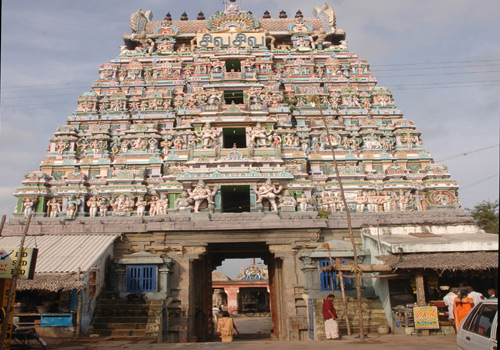Rampant intrusion on the land of temples rarely makes headlines. Sri Vedaranyeswarar temple in Nagapattinam, Tamil Nadu is one classic example of how these encroachments have majorly eaten up most of the income of temples.
They not only struggle with their incomes but also end up losing the majority of their land. The lands were mostly given to them so that they would earn income from the rent that could help them with various things conducted for the deity. However, they don’t get enough rent to increase their income; the rents are even far less from the market prices.
Vedaranyam is one of the oldest and historic Shiva temples that is considered sacred second after Rameswaram. It holds the religious sentiments as it is considered that Lord Rama stayed here before heading to Lanka.
As per British records, it is mentioned that the temple has a right over 23,000 acres of land. Out of it, 17,000 acres of land is under cultivators, mostly used for agriculture purpose, and saltpans. 2,426 acres of this 17,000 comes directly under the salt department.
The temple is said to be managed by a Tamil family living in Jaffna, Sri Lanka till 1920. The Rajas of Tanjore had granted 2400 acres of land of Agastiyampalli village to the temple as ‘enaam’. The land was mostly occupied by saltpans. However, when East India Company established its possession in 1806, it prohibited the manufacturing of salt.
In return, they promised to pay 1,848 Pagodas (1 pagoda equals 3.5 grams of gold) annually to the temple for taking up their land. 1200 pagodas were the rent which the temple got out of 1,848 and it was paid till the year 1858.
After Independence, the government agreed to maintain the same terms and decided to pay the annual rent to the trust of the temple. Interestingly it was only till 1937 and after that, the government took up the entire possession of the land under their salt administration.
The department pays an annual lease of just Rs. 4200 annually for the huge 2400 acres of land.
In 2019, the state government, after a case was filed in the Madras High Court, issued an order that it would be purchasing the land encroached by poor families so that temples can have a steady income. If the land is to be sold, the amount of money will be deposited in the name of the deity and would be used only for running the temple.
This is a welcome development but all temples are not so lucky. As many as 38,600 temples come under Hindu Religious and Charitable Endowments (HR & CE) Department. However, only 331 of these temples earn more than Rs 10 lakhs per annum. Over 34,000 other temples do not earn even Rs 10,000 per year despite having acres of land.
The collection of rent for the Srirangam Sri Ranganathaswamy temple is less than 10 per cent of the amount due. In Vaduvur temple, for instance, out of 5,000 acres of land given by Serfoji Maharaja, what is with the temple since 1866 is only 50 acres. The Varugunapandishwar temple in Tirunelveli had 4,500 acres of drylands till 1917. Now the holdings are said to be less than 3,000 acres. Similarly, Tiruvarur temple had 6,250 acres and now has less than 2,000 acres.


